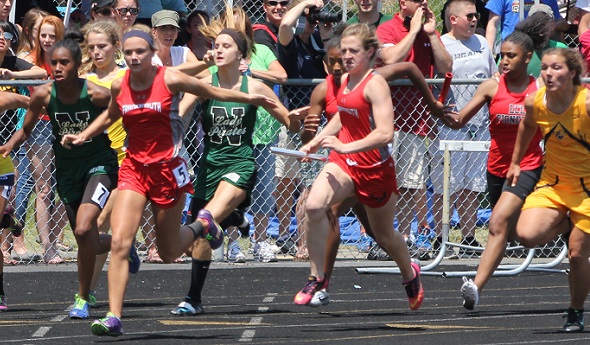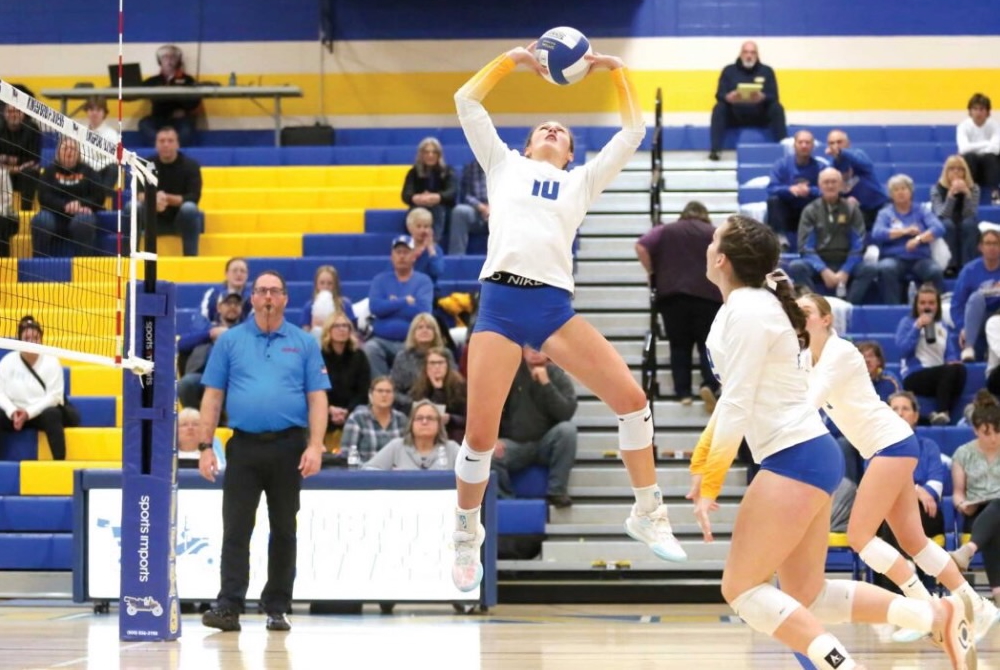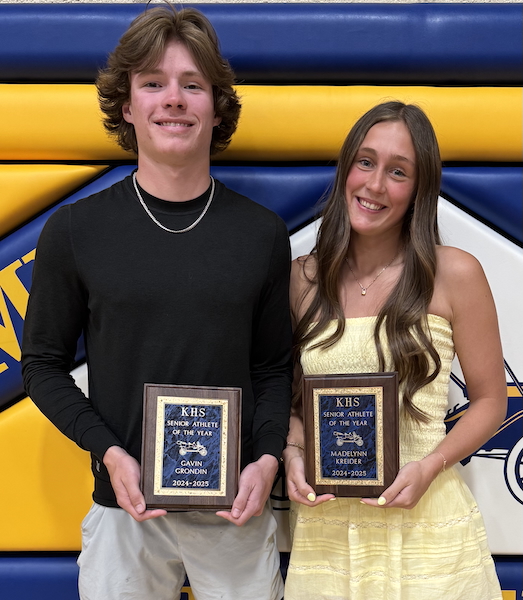
Frankenmuth Takes Back D3 Supremacy
May 31, 2014
By Butch Harmon
Special to Second Half
COMSTOCK PARK – After coming up short in its bid to repeat as MHSAA champions at last year’s Lower Peninsula Division 3 Girls Track and Field Finals, Frankenmuth was determined to not be denied this time.
With a squad that featured six top seeds and balance on the track and in the field events, the Eagles this time captured the title in impressive fashion as they outlasted last year’s champions, Pewamo-Westphalia.
The MHSAA title was the second in three years for Frankenmuth and fourth in the last six years for a program that is setting the standard for girls track and field in Division 3.
Sprinter Angie Ritter was one of the leaders. The senior, who was part of the title-winning team as a sophomore, was not about to let her career end without hoisting another championship trophy.
“I was real happy with what our team did,” Ritter said. “As a team we all performed up to par. Last year we had a few fallouts, but this year everyone did what was expected. We all came into the season with positive attitudes, and we talked about winning state this year.”
The day went according to form for the Eagles, who knew before the meet was over that they had won.
“By the time we got to the four by four (1,600 relay) we knew we had it,” Ritter said. “We were up by 26 points with one event to go, and we knew we got it.”
She did her part to help. Ritter, who will be running for Grand Valley State University next season, won both the 100 and the 200-meter dashes and was a member of the 800 relay team that also finished first.
“I was just hoping to get first in both the 100 and the 200,” Ritter said. “Winning a state championship says it all. I was pretty happy to win it all.”
Ritter also removed her sister’s name from the school record book in the process as her time in the 100-meter dash was three-tenths of a second faster than her sister Kelsey Ritter’s previous Frankenmuth best.
Angie Ritter was not the only Eagles standout to win a pair of individual titles. Junior Sydney Bronner captured the 100 hurdles and high jump, and like Ritter was also a member of the 800 relay champ.
Bronner placed in high jump last year but was determined to take the title and also set a new personal best of 5-6, something she accomplished in the final. That personal best also tied the LP Division 3 meet record.
“I took third last year,” Bronner said. “I wanted to take first this year. I tried seven or eight times at 5-6, and this time I finally did it. I was more confident this year and I also have improved my form.”
Second-place Pewamo-Westphalia didn’t let this year’s title go without a fight. The 400 relay team of seniors Jenna Thelen, Sasha Platte, Kenzie Wieber and junior Gabbie Hummel took first, and in the process set a new school record. For Thelen, Platte and Wieber, it was their final time competing together.
“It really helps having three seniors on the team,” Thelen said. “This was the last race for the three of us, and we wanted to go out with a win.”
“It was a blessing in itself,” Platte added. “We did great today. We did a lot of work for this, and our coaches helped lead us to this.”
Elkton-Pigeon-BayPort senior Kayla Deering wrapped up her high school career in a big way. A two-time MHSAA champion in the shot put, Deering closed with a third straight title with a put of 44-11. Deering, who will compete at the University of Michigan next season, also placed sixth in the discus.
“I was satisfied,” Deering said. “I really wanted the state record, but I was satisfied to win a third state title. I just tried to stay focused. I’m content, but it would have been nice to set a new personal best here.”
Manistee’s Annie Fuller battled through the heat of the afternoon to capture a pair of titles for a second consecutive year. A junior, Fuller won the 800 as a freshman. Last season she won the 800 for a second straight year and also added the 1,600 title. Saturday she again took titles in the 800 and 1,600.
“The heat didn’t help much,” Fuller said. “There was also definitely more pressure this year trying to repeat. The competition is real strong and you don’t want to lose.”
Fuller set personal records in both races and also helped Manistee finish third overall in the 1,600 relay, running the anchor leg.
Napoleon junior Kaniya Weatherspoon had only one jump in the long jump competition but she made it count. Weatherspoon jumped 17-4½ on her first attempt, and that leap was good for first place. She was scratched on her next two jumps as she suffered tightness in her quad muscle and wanted to save herself so she could contribute to the team score in other events. Weatherspoon went on to finish fifth in the 200 and helped Napoleon’s 400 and 800 relay teams finish among the top five. Those efforts enabled Napoleon to finish in fourth place overall.
PHOTO: Frankenmuth's Cadi Palmreuter (second from left) takes the baton from teammate Rebekah Barger during the 400 relay Saturday. The Eagles finished second in this race but won the meet. (Click to see more from RunMichigan.com.)

Kingsford's Kreider Prepared for Next Level After Finishing Stellar Flivvers Career
By
John Vrancic
Special for MHSAA.com
June 19, 2025
KINGSFORD — After completing a successful high school volleyball career, Maddy Kreider is ready to take the next step.
 The Kingsford senior is taking her talents to Michigan Tech, where she’s expected to continue primarily as a setter.
The Kingsford senior is taking her talents to Michigan Tech, where she’s expected to continue primarily as a setter.
“That will be a big step for sure, but it’ll be exciting being with the girls,” she said. “The girls are taller in college. It will definitely be an adjustment, physically and mentally. We’ll be traveling longer distances, and it’ll be a matter of improving the mental part of my game.”
Kreider was selected the Upper Peninsula’s Defensive Player of the Year her final two seasons after the U.P. Sportswriters and Sportscasters Association began voting for all-U.P. volleyball.
“That’s quite an accomplishment,” she said. “It’s a real honor playing with girls I grew up with. We had a great season.”
The 5-foot-8 setter was a four-year starter and two-year team captain at Kingsford, leading the Flivvers to three Division 2 District titles and back-to-back undefeated Great Northern Conference championships. She twice was named GNC Player of the Year.
She was also selected all-state first team in the fall and all-state second team in 2023, and all-region throughout her prep career. Her serving percentage also topped .900 throughout her four seasons on varsity.
 Last fall, the Flivvers reached the Regional Semifinal at Manistique where they dropped a 3-2 decision to Kingsley.
Last fall, the Flivvers reached the Regional Semifinal at Manistique where they dropped a 3-2 decision to Kingsley.
“I thought we’d get through,” Kreider said. “We came out lights out in the first two sets, then it was close in the last three.”
Also among the team’s highlights this past fall was a victory at Calumet, approximately 2½ weeks after dropping a 3-1 decision to the Copper Kings on Kingsford’s home floor.
“We wanted to play them,” Kreider said. “They’re a great bunch of girls to play against. They’ve been the measuring stick up here for many years. Winning on their floor was super exciting. We knew we had to play well just to be competitive. That was a great confidence builder for our group. We were definitely on a high going into the District.”
The Flivvers opened their postseason with a 3-1 triumph over Houghton, then defeated Escanaba in straight sets in the District Final.
Kreider will join Calumet senior Maddie Torola at MTU this fall. Torola, who recorded a season-high 19 kills in the four-set victory at Kingsford, helped the Copper Kings finish 29-5 and reach the Division 3 Regional Final at Sault Ste. Marie where they dropped a 3-2 decision to Traverse City St. Francis.
“It was fun playing against her in high school,” Kreider said. “It will be even more fun playing as teammates. It’ll be exciting to be playing on the same team.”
Both will be playing under new head coach Cindy Pindral at Tech. Both of Kreider’s parents played for the Huskies, her mother (and Kingsford varsity coach) Jaclynn volleyball from 1998-2002 and her father Jason basketball from 1997-2000.
Maddy Kreider recently earned an additional honor when she was selected Female Athlete of the Year for Kingsford’s Class of 2025. She recently completed a solid track & field season for the Flivvers.
At the U.P. Division 1 Finals, Kreider placed fourth in the 100-meter dash (13.2) and anchored the Flivvers to a third-place finish in the 800 relay (1:51.57) and fourth in the 400 (53.03) on their home track.
Kreider was named one of 32 MHSAA/Farm Bureau Insurance Scholar-Athlete Award winners this winter and plans to study exercise science and kinesiology at MTU.
 John Vrancic has covered high school sports in the Upper Peninsula since joining the Escanaba Daily Press staff in 1985. He is known most prominently across the peninsula for his extensive coverage of cross country and track & field that frequently appears in newspapers from the Wisconsin border to Lake Huron. He received the James Trethewey Award for Distinguished Service in 2015 from the Upper Peninsula Sportswriters and Sportscasters Association.
John Vrancic has covered high school sports in the Upper Peninsula since joining the Escanaba Daily Press staff in 1985. He is known most prominently across the peninsula for his extensive coverage of cross country and track & field that frequently appears in newspapers from the Wisconsin border to Lake Huron. He received the James Trethewey Award for Distinguished Service in 2015 from the Upper Peninsula Sportswriters and Sportscasters Association.
PHOTOS (Top) Kingsford’s Maddy Kreider sets for her teammates during a match last season. (Middle) Kreider, right, takes a photo with Kingsford’s Male Athlete of the Year Gavin Grondin. (Photos provided by the Kingsford athletic department.)

